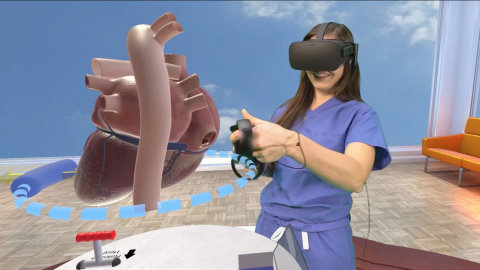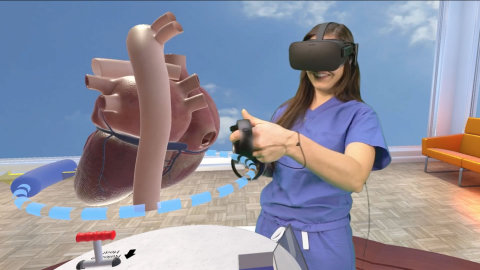PALO ALTO, Calif.--(BUSINESS WIRE)--Pediatric cardiologists at Lucile Packard Children’s Hospital Stanford are taking inspiration from the video-game and consumer technology industries to leverage virtual reality (VR) as a vital tool for providers and patients alike. The Virtual Reality Program at the Children’s Heart Center is going beyond gaming with three VR projects that are already improving patients’ education, health, and hospital experience and helping physicians treat cardiac patients more effectively.
“Because we are situated in Silicon Valley, we are in an ideal position to be a vanguard in this space and to partner with the companies that are on the cutting edge of this technology,” says Stephen Roth, MD, MPH, chief of pediatric cardiology and director of the Children’s Heart Center.
There are numerous ways that care teams at Packard Children’s are introducing VR use in the hospital. The Children’s Heart Center, whose leading Stanford pediatric cardiac specialists perform about 2,000 cardiac procedures each year, is an ideal place to develop and test some of these groundbreaking VR tools, each of which address a unique component of cardiac care.
Project 1: The Stanford Virtual Heart – Revolutionizing education for congenital heart defects
Pediatric cardiologists at Packard Children's are using immersive VR technology to explain complex congenital heart defects, which are some of the most difficult medical conditions for patients and their families to grasp. The Stanford Virtual Heart experience employs a new kind of interactive visualization that goes far beyond diagrams, plastic models and hand-drawn sketches.
Users put on a VR headset and use handheld controllers to interact with the virtual heart. They can rotate it, open it and inspect its different pieces, including the various heart defects. They can then “teleport” inside the heart to see the interior of the heart’s chambers and vessels and watch the circulation of blood throughout the heart. Once inside, users can see exactly where the defect exists, such as a hole in a septum or an improperly attached blood vessel (both common congenital heart defects). With a doctor close by to explain, the patient can more easily understand how stitches might close up a hole or how a vessel would be repaired.
For medical trainees, the program provides an immersive and engaging new way to learn about the most common and complex congenital heart anomalies, allowing them to inspect and manipulate the affected heart, walk around inside it to see how the blood is flowing, and watch how a particular defect interferes with the heart’s normal function.
The Stanford Virtual Heart was designed by Stanford cardiologists and cardiothoracic surgery experts along with VR education producers at Lighthaus Inc. When complete, there will be about two dozen heart defect models available in the VR experience. The program will be available to adolescents ages 13 and older and all patients’ parents and caregivers. Doctors say the new technology makes it much easier for everyone to understand congenital heart problems.
“The heart is a complicated three-dimensional organ, and it’s really hard to describe what’s going on inside of it — especially when something is going wrong,” explains David M. Axelrod, MD, clinical assistant professor of pediatrics at the Stanford University School of Medicine, who has led the design of the Stanford Virtual Heart program. “Virtual reality eliminates a lot of that complexity by letting people go inside the heart and see what’s happening themselves — it’s worth way more than a thousand words.” Axelrod is both a medical advisor to Lighthaus Inc. and a shareholder in the company.
David Sarno, co-creator of The Stanford Virtual Heart and founder of Lighthaus Inc., says cardiologists from around the world who have tried their program have agreed on VR’s potential to reshape medical education. He believes VR technology will be standard in hospitals and medical schools within the next two years.
The Stanford Virtual Heart was designed with support from Oculus, a subsidiary of Facebook.
Project 2: Project Brave Heart - Pilot study exploring the impact of VR therapy
A new study is being conducted on the use of a VR program for “stress inoculation therapy,” which aims to help young patients mitigate anxiety through cognitive behavioral therapy techniques, including relaxation and exposure. The study includes sending a VR headset home with patients who have a scheduled cardiac catheterization procedure so they can learn about the procedure and practice relaxation techniques at home. Although these catheterizations are outpatient procedures, catheterization patients must undergo general anesthesia. Doctors find the experience can cause stress and anxiety for patients, especially if they’re young. The study is being led by Anne Dubin, MD, professor of pediatrics, and Lauren Schneider, PsyD, clinical assistant professor of child and adolescent psychiatry.
The Project Brave Heart VR experience is driven by a proprietary app downloaded onto smartphones. The experience leads study participants, ages 8-25, through a virtual tour of what they will experience on the day of their procedure at Packard Children’s. It begins with checking into the hospital, shifts to falling asleep in the Cath Lab and concludes with waking up in the recovery room. Along the way, patients are introduced to the staff they will encounter (including nurses, technicians, and doctors), and they have opportunities to enter therapeutic relaxation and meditation experiences during moments of stress or anxiety. The relaxation programming includes content from three companies that specialize in VR programming: Life VR, Zen Zone and Dolphin Swim Club. VR equipment for the study was donated by Oculus.
By preparing children and adolescents for their hospital experience in advance, the Project Brave Heart program’s intent is to reduce stress and anxiety — and possibly the need for sedative medications — prior to the procedure. Patients in the study are instructed to participate in the VR experience at home several times during the week before their procedure. To determine the technology’s effectiveness as stress inoculation therapy, children’s heart rates, blood pressure and cortisol (a stress hormone) levels are measured before and after the catheterization and comprehensive questionnaires are administered to document the child’s reported levels of stress and anxiety.
“We want to find out if young patients who use VR have less anxiety because they have been exposed to a very realistic experience of what will happen at the hospital on procedure day,” says Dr. Dubin.
Virtual Ventures filmed and produced the VR program for the study in partnership with Rebecca Mandel Ben-Artzy, founder of AlphaPresence.
Project 3: 3-D virtual imaging technology inside the operating room helps surgeons map their route
A third program uses True3D virtual imaging technology to digitally convert computed tomography (CT) and magnetic resonance imaging (MRI) scans into 3-D images that can be viewed prior to surgery as well as in the operating room using a Hewlett Packard Enterprise Zvr Virtual Reality display. It allows pediatric cardiac surgeons to do a virtual run-through of a procedure before surgery using 3-D models that are constructed from CT and MRI scans. Frandics Chan, MD, PhD, associate professor of radiology at the Stanford School of Medicine, consulted on the development of the True3D technology with EchoPixel, a company based in Mountain View, CA. Chan has no financial relationship with EchoPixel or Hewlett Packard.
“When you print an anatomical model using 3-D printing techniques, you can cut the model open once and that’s it,” says Chan. “In virtual reality, you can put it back together, cut it again in a different place and magnify it with the flick of your hand.”
What’s next?
Although all three cardiac VR programs are in the early phases of implementation, doctors’ sights are set on how VR can be expanded across the hospital’s departments in the future. Once The Stanford Virtual Heart program is complete, there’s potential to develop a comprehensive VR education lab at Packard Children’s where patients with all types of conditions — cancer, neurological diseases, hearing issues and the need for organ transplants — will be able to learn more about their conditions using the technology.
Dubin and Schneider are already developing the next phase of their VR programming, which is aimed at encouraging young cardiac patients to exercise at levels that are safe for their heart conditions.
The True3D technology was used at Packard Children’s in December 2016, both in a highly publicized procedure to separate conjoined twins and in the first minimally invasive pulmonary valve replacement at the hospital. Looking ahead, it will help train radiologists and surgeons in the diagnosis and treatment of rare anatomic diseases by allowing trainees to use an electronic library of 3-D disease images to perform virtual dissections.
There are additional VR initiatives underway to help patients manage pre-operative and procedure-related stress. The Lucile Packard Foundation for Children’s Health is raising funds to expand the projects.
Dr. Roth hopes the initiatives that have begun in the Children’s Heart Center will continue to grow. “Thanks to our collaborators and supporters, we’ve leveraged this technology to make real progress in the medical field that can spread far beyond Stanford. It’s truly state-of-the-art, and we are very excited about it.”
About Stanford Children’s Health and Lucile Packard Children's Hospital Stanford
Stanford Children’s Health, with Lucile Packard Children’s Hospital at its core, is the Bay Area’s largest health care enterprise exclusively dedicated to children and expectant mothers. As the top-ranked children’s hospital in Northern California, and one of just 11 nationwide to be named on the 2016-17 U.S. News & World Report Best Children’s Hospitals Honor Roll, Packard Children’s Hospital is a leader in world-class, nurturing care and extraordinary outcomes in every pediatric and obstetric specialty. Stanford Children’s Health offers care ranging from the routine to rare, regardless of a family’s ability to pay. Together with Stanford Medicine physicians, nurses, and staff, Stanford Children’s Health can be accessed through partnerships, collaborations, outreach, specialty clinics and primary care practices at more than 60 locations across Northern California and 100 locations in the U.S. western region. As a non-profit, Stanford Children’s Health is committed to supporting the community – from caring for uninsured or underinsured kids, homeless teens and pregnant moms, to training the next generation of doctors and medical professionals. Recently celebrating the 25th anniversary of Lucile Packard Children’s Hospital in 2016, the organization looks forward to the 2017 debut of its expanded pediatric and obstetric hospital campus. Discover more at stanfordchildrens.org and on the Healthier, Happy Lives blog. Join Stanford Children’s Health on Facebook, Twitter, LinkedIn and YouTube.




